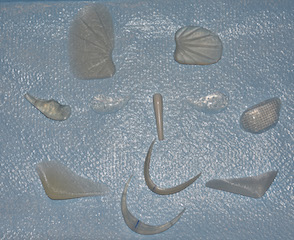
All facial implants are designed to highlight or augment weak facial bone structures. Most commonly, three specific areas are most commonly done including the cheeks, chin, and jaw angles. As a result, there are numerous sizes and styles for these frequently used implants.
But there are other areas of the face for which implants also exist including the nose, paranasal, maxilla, premaxillary, orbit, forehead and temple areas. Even if specifically shaped implants are not commercially available, carving blocks of various materials are available to ‘make your own’ for any specific facial need.
2. What are facial implants made of? Is one material better than another?
There are several synthetic materials from which most facial implants are manufactured. These include silastic (silicone), Gore-tex (polytetrafluoroethylene, and Medpor. (polyethylene) Each has some different handling properties which affects the flexibility and stiffness of the implants. While they are all chemically and structurally different, the body sees them all the same way…as a foreign material which it tolerates by surrounding it with scar tissue. (capsule)
Each plastic surgeon may have their preference but that is not based on whether it is a ‘better’ implant material. It is a function of what they are familiar with and have had good experiences. For me, I am more interested in the shape of the implant that I need to treat the patient’s problem and the ease with which it can be placed in the correct anatomic position. The actual material composition is not that the most critical factor.
3. How are facial implants placed?
The method of introduction, or incision, is most commonly done through the mouth. Short of farway places on the skull and orbit, all facial implants locations can be reached intraorally. This approach offers numerous advantages over an external skin approach. The one exception to this is for chin implants. They usually are best inserted through a skin incision under the chin which is associated with fewer potential complications.
4. How do you select the right size of a facial implant?
The sizing of any specific implant has a lot to do with experience and an artistic judgment. Some facial areas, like the chin, can be measured and the exact amount of augmentation needed can be precisely determined.
But most facial augmented areas are not profile structures so they lack a silhouette or outline which can be easily measured. This is why many implants have intraoperative sizers. By initially placing a temporary implant to determine what effect it creates, a final sterile implant is not opened until one is certain the effect matches what the patient wants.
5. What can go wrong with facial implants?
Like any synthetic material placed into the body, there is the risk that it can become infected. When infection occurs around an implant, it can be difficult to eradicate with antibiotics alone. Often the implant may need to be removed. Many people mistakenly think an infection is the body rejecting the implant but that is not so.
While infection is the worst complication of a facial implant, it is fortunately very uncommon. The more common problems are aesthetic…size and position issues. Implants can be too big or not big enough, creating too strong or too weak of an effect. The implant(s) can be off center (chin) or asymmetric. (cheeks and jaw angles)They can also shift for their desired position after surgery. This is why some plastic surgeons secure them into position with a screw.
6. Can multiple implants be used in a single facial surgery?
Yes. Implants are often part of many combined facial procedures. Most commonly, chin implants are used in rhinoplasty and facelift surgery to improve the lower facial profile. A multiple implant strategy is part of sculpting the male face and may include cheek, chin and jaw angle implants all together. Cheek and maxillary implants can bring out a flat or recessed midface.
The use of facial implants is only limited by the imagination and artistic eye of the plastic surgeon. Computer imaging can help one understand what effect one or more facial implants may cause.
7. When should facial implants not be used?
The long-term success of facial implants is primarily determined by the amount of healthy soft tissue around them. A good barrier or buffer of soft tissue is needed between the overlying skin and the inside of the mouth.
Implants have a much higher rate of complications in facial sites that have received radiation or been scarred by prior surgery or injury. Patients that are edentulous (without teeth) are also at risk as they have less bone and overlying soft tissue onto which to place and keep an implant adequately covered.
Dr. Barry Eppley
Indianapolis, Indiana


